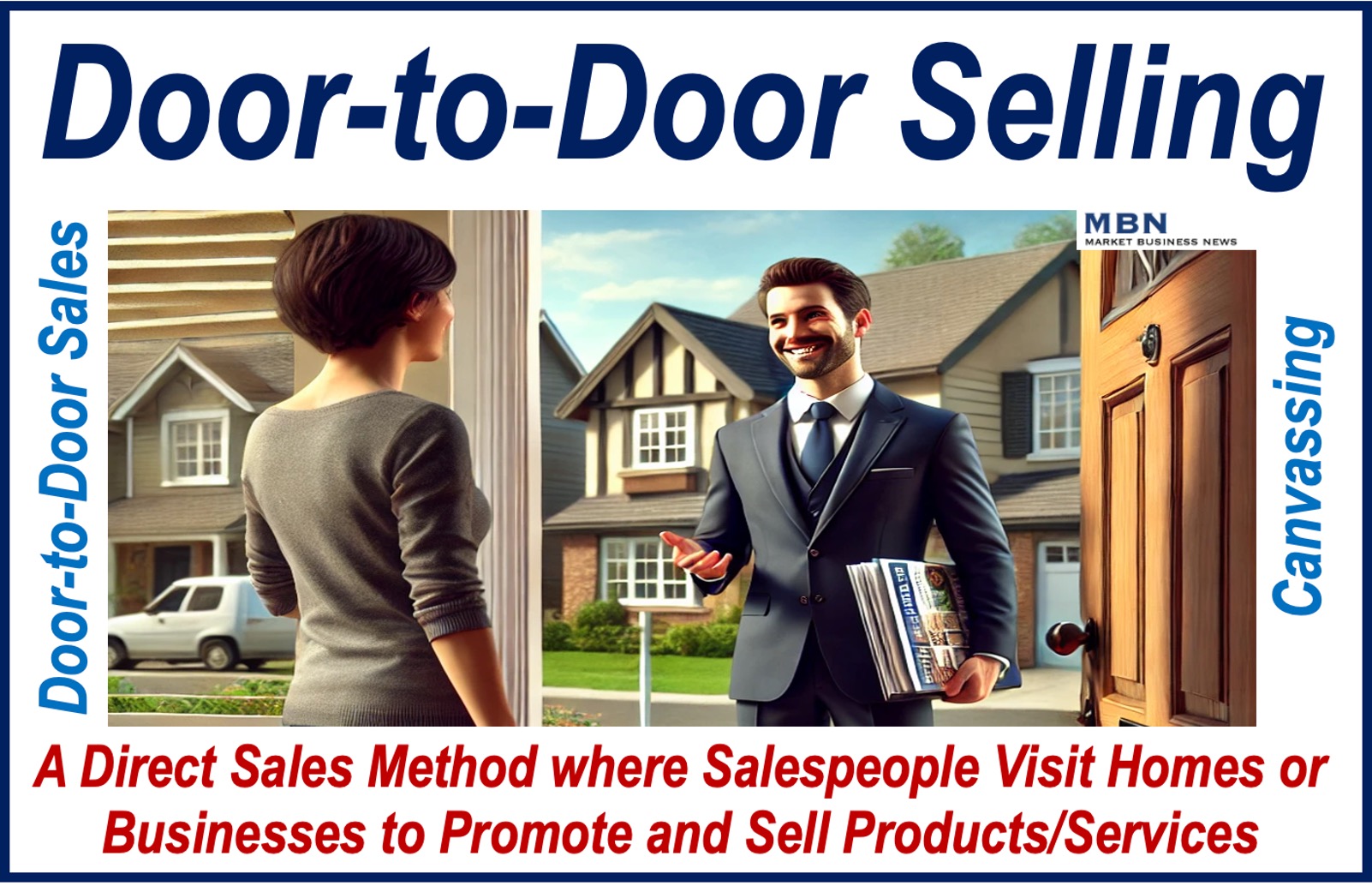Do you visit your potential customers at their homes to promote and sell your products? Do you knock on people’s doors without them knowing anything about your visit beforehand? If so, you practice Door-to-Door Selling or Door-to-Door Sales – you are a Door-to-Door Seller or Door-to-Door Salesperson.
In the English language, such terms as ‘salesman’ and ‘saleswoman/saleslady’ are gradually giving way to the more inclusive and non-gender specific ‘salesperson.’
While some salespeople visit their prospects at home, others visit them at their offices, and some do both.
Joburn.com has the following definition of door-to-door selling:
“Door-to-door selling is a method of direct sales where a salesperson visits potential customers at their homes or workplaces in order to promote and sell products or services. It is also known as ‘canvassing’ or ‘street selling.’ This type of sales approach can be used for a wide variety of products, including home appliances, household goods, magazines, and insurance products.”
Brief History of Door-to-Door Selling
Door-to-door selling is a direct sales method which has been around for a very long time. Its origins can be traced back to ancient times, including the Roman and Greek periods.
In ancient Rome and Greece, merchants and peddlers would travel from place to place, selling their goods directly to people in their homes or public places. These early forms of door-to-door sellers carried their wares on their back or in carts, offering items like tools, clothing, food, and other essential goods.
It was a practical way to reach customers who did not have easy access to markets or shops.
Door-to-door selling has persisted through the centuries, adapting to various economic and cultural changes. In medieval Europe, for example, they were often referred to as ‘hawkers’ or ‘peddlers.’
During the 20th century, door-to-door selling became more formalized with the rise in companies like Avon and the Fuller Brush Company, which employed hundreds of salespeople to sell their products directly to customers in their homes.
Door-to-door selling remains a significant, though evolving, method of direct sales even today.

Personal Interaction and Direct Engagement
As a door-to-door seller, you probably carry the product, samples, or brochures with you and provide detailed information about what you are offering.
This approach allows you to interact with potential customers in person, giving them the opportunity to ask questions, see the product up close, and make a purchase decision on the spot.
The personal nature of this sales method can help you create a strong connection with potential customers, leading to higher levels of trust and engagement.
Reaching New Customers Directly
One of the key aspects of door-to-door selling is its ability to reach customers who may not have been aware of your product or service otherwise.
By coming directly to their door, you introduce something new to them, potentially fulfilling a need or solving a problem they didn’t know they had.
This method can be especially effective for products that require demonstration or detailed explanation, as you can tailor your pitch to their specific needs and preferences.
The Advantage of Immediate Feedback
Door-to-door selling also allows for immediate feedback. If a customer has concerns or objections, you can address them right away, potentially overcoming barriers that might prevent a sale.
This face-to-face interaction is more personal and dynamic than other sales methods, such as online or over-the-phone sales, where the lack of direct contact can sometimes make it harder to build trust.
Challenges of Door-to-Door Selling
However, door-to-door selling also comes with challenges. It requires a lot of time and effort on your part, as you must often visit many homes or businesses before making a sale.
Customers might also feel interrupted or pressured when you unexpectedly come to their door.
As a successful door-to-door salesperson, you should be well-trained in handling objections and building rapport quickly, ensuring that the experience is as positive as possible for the customer.
However, some people will respond rudely or aggressively, perhaps even hurling insults at you. You must not let that get you down. Whenever this happens to you, tell yourself that you are now one step closer to a paying customer.
Door-to-Door Selling and Technology
In recent years, door-to-door selling has evolved to incorporate technology. You might now use tablets or smartphones to show videos, gather customer information, and even process payments on the spot.
This integration of technology helps make the process smoother and more efficient for both you and your customers. It may also help improve your *conversion rate.
* The term conversion rate refers to the percentage of visits or presentations that end up as sales. For example, if you made 200 presentations last month and achieved 50 sales or orders, your conversion rate was 25% or 1-in-4.
Companies Leading the Way in Door-to-Door Sales
Many companies today have teams of door-to-door salespeople. Here are some details on eight of them:
-
Avon
Based in: London, United Kingdom
Annual Sales/Revenue: Approximately $3.63 billion (2022)
-
Vivint
Based in: Provo, Utah, USA
Annual Sales/Revenue: Approximately $1.66 billion (2022)
-
Mary Kay
Based in: Addison, Texas, USA
Annual Sales/Revenue: Approximately $2.7 billion (2022)
-
Amway
Based in: Ada, Michigan, USA (Headquarters), Registered in the Netherlands
Annual Sales/Revenue: Approximately $8.1 billion (2022)
-
Vorwerk
Based in: Wuppertal, Germany
Annual Sales/Revenue: Approximately $4.3 billion (2022)
-
Tupperware
Based in: Orlando, Florida, USA (with a significant global presence)
Annual Sales/Revenue: Approximately $1.3 billion (2022)
-
Oriflame
Based in: Schaffhausen, Switzerland (registered office), Stockholm, Sweden (head office)
Annual Sales/Revenue: Approximately $1.3 billion (2022)
-
Herbalife
Based in: Los Angeles, California, USA
Annual Sales/Revenue: Approximately $5.2 billion (2022)
Final Thoughts
Overall, door-to-door selling remains a relevant and effective sales strategy, particularly for products that benefit from direct demonstration or personalized explanation.
Whether your customers view it as an opportunity to discover new products or as an occasional inconvenience, it is a sales method that continues to connect businesses with customers in a direct and personal way.
Good luck in your sales endeavors!
